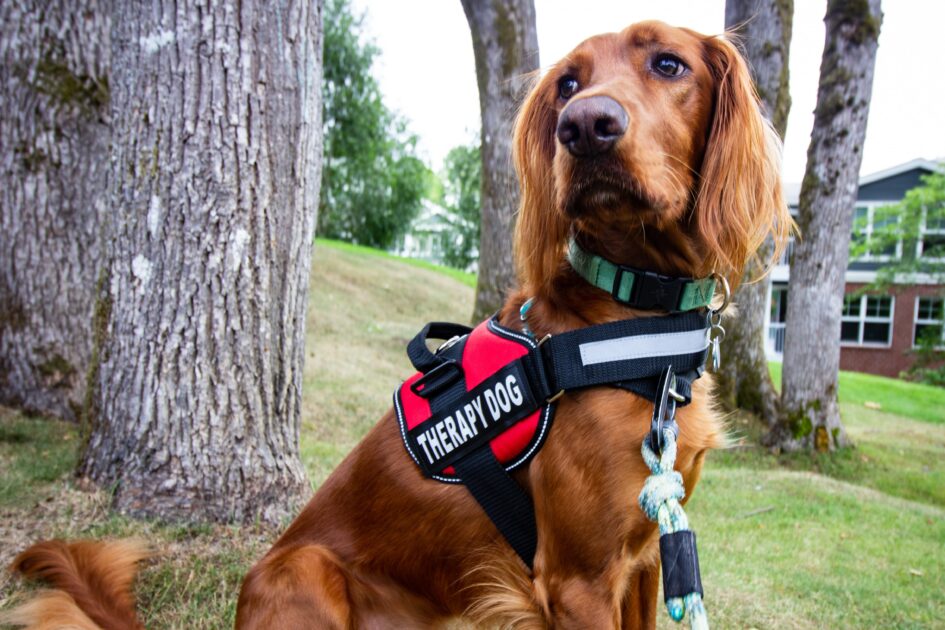This week I wanted to learn more about therapy dogs and how we as future teachers can have access to this resource for our students. Here is the video that sparked my interest in researching therapy dogs positive impact on students in elementary classrooms:
I wanted to focus on resources available in Canada. Companion Paws is a foundation with two main goals. One being to support Canadians by means of Therapy dogs and secondly, it has a lifeline (TLC) program that gives dogs with a good temperament a second chance through adoption.
Companion Paws Canada introduced me to the integral difference between Therapy and Service dogs. They both have the same goal of positively affecting the well-being of humans; however, service dogs work with one individual and have certain public rights, whereas, therapy dogs are trained to help a multitude of individuals. Companion Paws Canada is a foundation to certify/ re-certify yearly Therapy dogs not service dogs.
Through Companion Paws Canada their are 3 different types of therapy dogs:
- Personal Therapy Dogs: When an owners dog is specially trained to positively influence their mental well-being (Main focus is to help with mental illness).
- Assisted Therapy Dogs: These dogs work alongside their owners at their workplace. I hope one day I have a dog that I can certify and bring into classes to help students.
- Visiting Therapy Dogs: When an individual brings their dog to a facility to help students/ patients. On the Campanion Paws Website you can submit a request for this. This would be great to help in classrooms if we do not have our own therapy dog trained for assisted therapy!
I wondered, How to Certify your own Dog? The foundation has a 4-step certification process:
1- First Temperament Assessment ($55)
2- Therapy Dog Skills Training Online Course
3- A Second Temperament Assessment
4- Final Evaluation ($250 in total for steps 2,3,4)
It would cost a total of $305 dollars to certify your own dog plus an annual $95 re-certification. The closest testing centre to Cranbrook is Calgary, A.B.
There is strict criteria that a dog must have to qualify with Companion Paws Canada:
- * Good Temperament*: Calm, friendly, patient, confident, gentle, and at ease in all situations.
- Age: Minimum of 1.5 years old
- Very well trained
- Healthy
- Up to date on all vaccinations
- Spayed/ neutered
My dream one day is to not only welcome a therapy dog in my classroom for students but to certify my own dog to do this!

Here is a video recap of my post from the Companion Paws Canada Foundation:
Thank you for engaging with me on learning about Companion Paws Canada this week. I hope I was able to provide you ways that animal assisted therapy can be utilized in classrooms and how to submit a request to do this or even with your own pet!
Chelsea
References
Companion paws canada therapy dog program – certify your own dog. Companion Paws Therapy Dogs. (2022, June 1). Retrieved October 2, 2022, from https://companionpaws.ca/
NBCActionNews. (2017, October 3). Therapy dog calms kids at independence elementary school. YouTube. Retrieved October 1, 2022, from https://www.youtube.com/watch?v=HK7srQ2Nfd0
YouTube. (2021, April 16). Companion paws canada introduction. YouTube. Retrieved October 2, 2022, from https://www.youtube.com/watch?v=1sl3w4Gt1o8

October 12, 2022 at 8:19 pm
Wouldn’t it be SO amazing to have a therapy dog in your classroom?! Sure, the dog could be a little distracting at times but, as a whole, the dog could really help with mood and behaviors. Just last year, I was working with a student who needed frequent outdoor “breaks”; how amazing would it be if that student had a little “job” of taking the dog for a walk during that time? And what a great way to tie in “Career Education” by discussing some roles and responsibilities of having a pet at school or at home.
I love your inquiry project Chels! I look forward to learning more from you!
October 13, 2022 at 4:59 pm
Thank you Kimberly!
That is a great idea having a child walk the dog to give them a role and responsibility that they would enjoy doing! I can see how this would provide them dignity and purpose. Thank you for taking part in my blog this week.